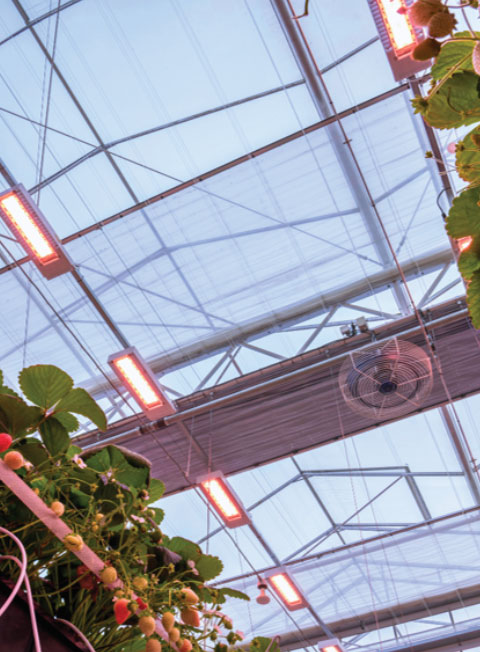4/30/2025
Extending the Growing Season
Tim Wright

Svensson Climate Consultant Paul Arena is having more conversations with vegetable growers about extending the growing season. But isn’t that working against nature? Isn’t there supposed to be a fallow time when it’s cold? Or a pause in growth at the height of summer?
Left: Svensson Climate Consultant Paul Arena works with growers all over North America to address specific climate issues in their greenhouse.
We asked him for more details about how growers can plan for extreme summers and winters.
Paul Arena: Well, this might sound blunt, but it comes down to the fact that growers don’t just have a crop, but also a business to grow. If our customers can make their produce options available to consumers during these earlier or later times in the year, then they have an opportunity to capture market share that they’re currently forced to give up. And that’s usually the starting point I find.
We recently spoke to a customer in the Northeastern United States that we work with. They grow flowers throughout the hotter parts of the year and then during the winter they have reproduction space and labor that they have to account for. So why not maximize that space by extending the growing season into those colder periods?
Things become a lot more versatile, I would say. There might not be great above-the-line profits right away, but if you have capital employed and a core labor team that you want to retain year-round, then there can be quite an upside to using those winter periods.
 Right: For growers facing challenges with summer shading, PARperfect, Svensson’s dual-screen solution, offers precise, adjustable shading for consistent light distribution and optimal crop growth.
Right: For growers facing challenges with summer shading, PARperfect, Svensson’s dual-screen solution, offers precise, adjustable shading for consistent light distribution and optimal crop growth.
Tim Wright: Yes, you said you’re seeing season extension as quite a trend in more southerly Canada and colder regions of the U.S. What are the challenges this poses from a climate point of view?
PA: Well, for starters, there’s likely to be supplementary lighting involved. And with the change to LEDs that’s taking place, it does require a different type of thinking from the growing team about heat distribution, leaf temperatures and air movement.
Specifically, High-Pressure Sodium (HPS) lights radiate much more heat to the crop, promoting warmer head and leaf temperatures. In contrast, the newer LEDs do not radiate heat; it rises upwards off the lights. Therefore, with LEDs, head and leaf temperatures are lower, requiring re-introduction of heat back into the canopy using vertical air movement. Additionally, lower leaf temperatures with LEDs lead to more condensation on the crops, resulting in moisture issues that necessitate more air movement.

TW: Paul, I know you’ve been working with growers who have the opposite challenge at the other end of the season. What are people doing to extend into the summer when it’s very hot?
PA: Well, you’ll want shade, but we see a lot of growers struggling with a single-screen, high shade level solution. Oddly, shade is a good thing, but shadows can wreak havoc in a crop. Strong shadows lead to uneven growth, which would create inconsistency within the crop.
Left: Growers transitioning from HPS to LED lighting can leverage vertical airflow systems, such as Svensson’s Climaflow, to support with heat distribution in the greenhouse.
There, we are often inviting people to explore what we call PARperfect, where a blackout screen above is combined with a diffusing screen below. The shadow lines are nearly gone, they get precise control—from 20% shade to 100% (or blackout), then come the benefits of a homogeneous growing climate.
Instead of having to spend time looking after edgy or patchy crops, they’ll find they get a predictable, uniform response from the plants below. From there, they can really start to manage one, single indoor climate and tweak performance, instead of applying resources to this microclimate or that patch of problem crops.
TW: Are there rebates available to help growers make the switch to new technologies like vertical ventilation or the double- or triple-screen solutions you work with?
PA: Absolutely. Rebates vary by state. There are federal programs, utility programs and electrical incentives. The process can be intricate, but our team supports growers by researching available rebates and assisting with the enrollment process. We even have comprehensive rebate guides for download that we keep up to date.
TW: What about the energy costs of using more of the winter weeks for growing?
PA: Energy saving is crucial. We’ll work with a grower and dive into monitoring how screens are used and what energy savings can be achieved from adding another screen system. With gas prices going up, the cost of heating greenhouses is affecting profitability. Screens are a huge part of the picture, but they must also let as much growing light through as possible during those darker winter days.
If you’re finding you have questions about getting the best out of a move to extend the growing season, Paul is part of a Svensson team that can offer advice, but can even equip you with advice and a kit to be able to run a trial of vertical ventilation. And don’t hesitate to get in touch to take advantage of their years of experience in light, shade, diffusion and energy saving.
Tim Wright is Svensson’s Content Specialist based on the west coast of Sweden. Tim is a seasoned journalist, marketer and—in his spare time—habits coach, who was once told to “keep that tape,” after interviewing a young Tony Blair (who became UK Prime Minister).